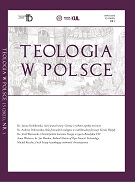Artykuł przypomina wzmiankowaną tylko jeden raz w Ewangeliach postać prorokini Anny, która „nie rozstawała się ze świątynią, służąc Bogu w postach i modlitwach dniem i nocą” (Łk 2,37). Powstaje pytanie o znaczenie tak szczegółowego jej opisu. Następnie poddano analizie kwestię możliwości wychowywania Maryi w obrębie jerozolimskiej świątyni pod okiem Anny. Wreszcie w treści opracowania zaprezentowano podstawy biblijne potwierdzające taką możliwość, która ma oparcie w opiniach teologów i tradycji liturgicznej Kościoła. Artykuł wydobywa teologiczne implikacje ślubu Dziewicy Maryi oraz Jej przebywania we wczesnych latach swego życia w najświętszym miejscu religijnego kultu Izraela. Końcowe wnioski ogniskują się na przecięciu soteriologii i antropologii, teologii duchowości i mariologii obiektywnej, dla której osią interpretacji wydarzeń zbawczych jest realizacja odwiecznych zamysłów Trójcy Przenajświętszej.
SUMMARY
This article recalls the figure of the prophetess Anna, mentioned only once in the Gospels, who “never left the temple but worshipped night and day, fasting and praying“ (Lk 2:37). A question arises as to the meaning of such a detailed description of it. Then the question of the possibility of rearing Mary in the Jerusalem temple under the supervision of Anna was analyzed. Finally, the content of the study presents the Biblical foundations confirming such a possibility, which is based on the opinions of theologians and the liturgical tradition of the Church. The article seeks to reveal the theological implications of the Virgin Mary’s vow and her staying in the most holy place of Israel’s religious worship in the early years of her life. The final conclusions are focused on the area of intersection of soteriology and anthropology, theology of spirituality and objective Mariology, for which the axis of interpretation of salvific events is the implementation of the eternal plans of the Holy Trinity.
Ostatnia aktualizacja: 25.07.2022, godz. 14:09 - Marcin Walczak































